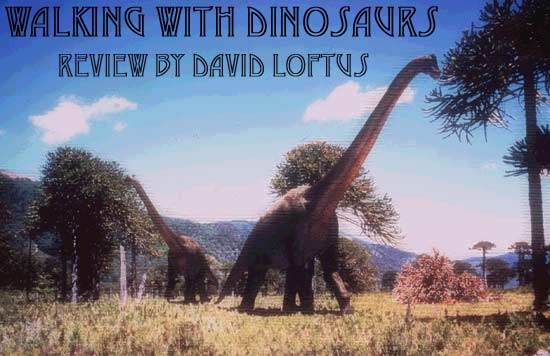|
Part 3: A Cruel
Sea
Time: 149 million years BCE
Place: "Oxfordshire,"
where the future continent of Europe lies mostly beneath azure
waters
Actual Locations: The Bahamas,
New Caledonia
This episode opens with the biggest
joke of the series. "The most fearsome predator of the Jurassic
is watching his prey," Branagh intones, as Eustreptospondylus,
a medium-size allosaur first seen in shimmery reflection, peers
into the water at ocean�s edge. We get a closeup of his slowly
blinking eye, then pan down to shiny white teeth with flecks of
bloody red tissue in them as the narration continues: "Peering
through the water, the carnivore fixes on his unwary victim, waiting
for the perfect moment to strike." The camera pulls back
to show the dinosaur poised on a narrow spit of land, looking
down into the relatively calm waters of a bay.
Suddenly a MASSIVE head
as big as the dinosaur�s entire 16-foot body EXPLODES out
of the ocean behind him, sweeps him up in its teeth, and disappears
beneath the waves with the flash of a flipper almost as long as
the land animal. The episode title materializes with a dismayed,
dissonant musical chord.
Quite droll, as the Brits would
say.
We have gotten a glimpse of this
episode�s "heavy," the 80-foot, 150-ton behemoth with
teeth twice as long as a Tyrannosaur�s and four flippers each
measuring 10 feet, called Lipleurodon. He is the "largest
and most powerful carnivore ever to live on the planet."
A slow and stately swimmer, the shots of him remind one of nothing
so much as the giant space ships of "Star Wars."
The known world now consists of
two large continents separated by the Tethys Ocean, and a string
of islands in vast shallow seas. Land animals of this era get
some screen time�Eustreptospondylus, the garishly red-headed pterosaur
Ramphorhynchus, even an amusing sequence of a land dinosaur "dog
paddling" from one island to another (including a closeup
of head and jaws in profile, pushing through the surface water)�but
most of the episode is devoted to sea creatures.
The cuddly protagonist is Ophthalmosaurus,
a swift and supple 16-footer that looks a lot like a dolphin but
has�you guessed it�extra large eyes (for hunting at night or at
great depths). There are cute sequences of baby Ophthals hiding
in coral from sharks, and making a mad dash to the surface for
air.
Not all references to these creatures
offer warm fuzzies, however. Exhausted after performing a tail-first
live birth underwater, a mother Opthalmosaurus is snapped in pieces
by Lipleurodon, and we get a fairly long look at a ripped piece
of her tail falling lazily toward the sea floor and "smoking"
a little with residual blood before it strikes the bottom tight
in the frame, with sharks moving in on the dark bits of floating
flesh. You realize with a start that the filmmakers are quoting
the leg-in-the-tennis-shoe bit from "Jaws."
The marine version of the gentle
herbivorous giants on land is the pleisosaur Cryptoclidus. Branagh
explains that the ancestors of all the sea reptiles lived on land,
but took back to the water 75 million years previous. In addition
to the dinosaurs, this episode features intoxicatingly beautiful
underwater shots of jellyfish, blizzards of tiny fishes flashing
balletically around a Cryptoclidus, and Perisphinctes (ammonites)
floating slowly on the ocean currents like hot-air balloons. Hordes
of horseshoe crabs clamber onto a beach at high tide to mate and
lay eggs�as many as 18,000 at a time.
A time lapse shot of a sunrise
through trees in an estuary shows wind patterns streaking across
the surface of the water. A closeup of tiny, opaque silver-white
horseshoe crab babies is also gorgeous. Another brief sequence
of senseless beauty depicts a ribbon of squid fragment drift-fluttering
toward the bottom for a good 10 seconds after being torn by an
Opthalmosaurus jaw.
Similar to the forest fire in part
2, this episode includes a violent tropical storm that tears up
shallow sea beds, smashes coral, and kills thousands of marine
animals, but is not milked to obnoxiousness.
There is a bit of pathos at the
close for the giant killer Lipleurodon, one of whom gets stranded
on the beach by the storm, suffocates under the weight of his
own body, and begins to get torn apart by a herd of scavenging
Eustreptospondylus.
|

